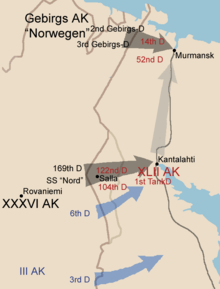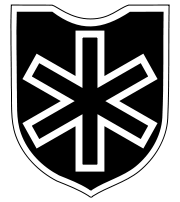6th SS Mountain Division Nord
| 6th SS Mountain Division Nord | |
|---|---|
|
Divisional insignia (Hagall rune) | |
| Active | September 1941 – May 1945 |
| Country |
|
| Allegiance | Adolf Hitler |
| Branch |
|
| Type | Gebirgsjäger |
| Role | Mountain warfare |
| Size | Division |
| Commanders | |
| Notable commanders |
Matthias Kleinheisterkamp Lothar Debes |
The 6th SS Mountain Division Nord was a German unit of the Waffen-SS of Nazi Germany during World War II, formed in February 1941 as SS Kampfgruppe Nord (SS Battle Group North).
The division was the only Waffen-SS unit to fight in the Arctic Circle when it was stationed in Finland and northern Russia between June and November 1941. It fought in Karelia until the Moscow Armistice in September 1944, at which point it left Finland. It fought in the Operation Nordwind in January 1945, where it suffered heavy losses. In early April 1945, the division was destroyed by the U.S. forces near Budingen, Germany.
Operation Barbarossa

The division was formed from the units of the SS-Totenkopfverbände (concentration camp guards) to guard the border with the Soviet Union following the 1940 German occupation of Norway. In the spring of 1941, the newly formed division was moved into positions at Salla in northern Finland with General Nikolaus von Falkenhorst in command.
During the invasion of the Soviet Union, Operation Barbarossa, the unit took part in Operation Arctic Fox. The Brigade got a new unit attached, SS Gebirgsjäger (Mountain) Artillery Regiment 6, and was now designated as a Division, the SS Division Nord. In September 1941 the division was attached to the Finnish III Corps under General Hjalmar Siilasvuo, and took up new positions at Louhi, Kiestinki. By the end of 1941, it had suffered heavy casualties. Over the winter of 1941–42 it received replacements from the general pool of Waffen-SS recruits.
1942–1945
Throughout the rest of 1942 and through 1943 it remained on the Kestenga front, which was quiet compared to other areas of the Eastern Front. In September 1942, the unit was renamed as the SS Mountain Division Nord. In September 1944 it was ordered to withdraw from Finland, upon the conclusion of a separate armistice between Finland and the Soviet Union. The division then formed the rear guard for the three German corps withdrawing from Finland in Operation Birch and from September to November 1944 marched 1,600 kilometers to Mo i Rana, Norway, where it entrained for the southern end of the country. The Norwegian Ski-Battalion unit was then left behind, in accordance with their contracts. They were merged into "SS-und-Schi-Jäger-Polizei-Battalion 506 (mot.) with app. 50% men from different German Police units in South Norway. The rest of the division was transferred to Germany.
The division briefly refitted in Denmark where its losses were replaced by young Volksdeutsche (ethnic Germans) who had been conscripted into the Waffen-SS and received only a brief training. The division took part in Operation Nordwind in the Low Vosges mountains of southeastern France. By 2 January, part of the division (SS Gebirgs Regiment 12 and 506th Battalion) went into action against the U.S. 45th Infantry Division, attached to 361st Volksgrenadier Division. For six days the SS men fought in and around the town of Wingen, finally being pushed back by the U.S. forces with most of the battle group killed or captured. On 16 January, the SS Regiment 11 surrounded six companies of the American 157th Infantry Regiment. The American troops were forced to surrender three days later, losing 482 men. Nord advanced for four more days before being stopped by American counterattacks.
The division remained on the western front after the Nordwind offensive, fighting American forces around Trier and Koblenz on the Moselle River in March. By Easter 1945 it numbered about 2,000 soldiers, including stragglers from other units. It still had six howitzers and an assault gun. The division refused to give up, and moved east to re-establish contact with other German units. However, as it moved, it drew the attention of the US Army by cutting American lines of communication. In early April 1945 over the course of several days the U.S. 71st Division fought a series of meeting engagements with the 6th SS Division Nord. As a result, the division was destroyed; its personnel scattered or captured.
Commanders
- Brigadeführer Karl Herrmann, (28 February 1941 – 15 May 1941)
- Obergruppenführer Karl-Maria Demelhuber, (15 May 1941 – 1 April 1942)
- Obergruppenführer Matthias Kleinheisterkamp, (1 April 1942 – 20 April 1942)
- Oberführer Hans Scheider, (20 April 1942 – 14 June 1942)
- Obergruppenführer Matthias Kleinheisterkamp (14 June 1942 – 15 January 1944)
- Gruppenführer Lothar Debes, (15 January 1944 – 14 June 1944)
- Obergruppenführer Friedrich-Wilhelm Krüger, (14 June 1944 – 23 August 1944)
- Brigadeführer Gustav Lombard,(23 August 1944 – 1 September 1944)
- Gruppenführer Karl Brenner, (1 September 1944 – 3 April 1945)
- Standartenführer Franz Schreiber, (3 April 1945 – 8 May 1945)
Area of operations
- Finland & northern Russia (June 1941 – November 1944)
- Norway & Denmark (November 1944 – January 1945)
- Western Germany (January 1945 – April 1945)
- Austria (April 1945 – May 1945)
Manpower strength
- June 1941: 10.373
- December 1942: 21.247
- December 1943: 20.129
- June 1944: 19.355
- December 1944: 15.000
Order of battle
- Order of battle 1941
At its inception in September 1941 the division was made up of the following units:[1]
- Division Staff
- SS-Infantry Regiment 6
- SS-Infantry Regiment 7
- SS-Infantry Regiment 9 (left the division in December 1941)
- SS-Gebirgs Artillery Regiment "Nord"
- SS-Panzerjäger (Tank Hunter) Battalion "Nord"
- SS-Reconnaissance Battalion "Nord"
- SS-Flak Battalion "Nord"
- SS-Gebirgs Engineer Battalion "Nord"
- SS-Gebirgs Signal Battalion "Nord"
- SS-Division Supply Commander "Nord"
- Order of battle 1942
After being designated SS-Gebirgs-Division „Nord“ on 15 January 1942 the division's units were all renamed as Gebirgs (Mountain) units and the infantry regiments renamed and renumbered. The division was given the number 6 on 22 October 1943. The new structure was as follows:
- Division Staff
- SS-Gebirgsjäger Regiment 11 "Reinhard Heydrich" with three battalions
- SS-Gebirgsjäger Regiment 12 "Michael Gaismair" with three battalions
- SS-Infantry Regiment (motorized) 5 (added in 1944)
- SS-Skijäger Battalion "Norge" (a Norwegian volunteer unit)
- SS-Gebirgs Artillery Regiment 6 with three artillery groups
- SS-Werfer Battalion 6 (Rocket artillery)
- SS-Gebirgs Panzerjäger Battalion 6 (Anti-tank cannons)
- SS-Gebirgs Reconnaissance Battalion (motorized) 6
- SS-Flak Battalion 6 (Anti-aircraft artillery)
- SS-Gebirgs Engineer Battalion 6
- SS-Gebirgs Signal Battalion 6
- SS-Division Supply Commander 6
- SS-Feldersatz Battalion 6 (Reserve and training battalion used to prepare new arrivals to fill up depleted units)
- SS-Sturmgeschütz Battery 6 (Assault Guns)
- SS-Gebirgs-Kriegsberichter Platoon 6 (Propaganda Platoon)
- SS-Feldgendarmerie Platoon 6 (Military Police)
See also
Footnotes
Further reading
- George H. Stein - The Waffen-SS: Hitler's Elite Guard at War 1939–1945

